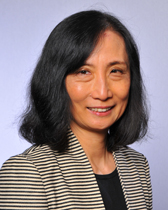Faculty Spotlight: Lin X. Chen

By Irena Garic
Lin X. Chen is a Professor of Chemistry at Northwestern University and a Senior Chemist in Argonne National Laboratory. She received her Ph.D. from the University of Chicago. After her postdoctoral research at UC Berkeley, she joined Argonne as a staff scientist. In 2007, she joined Northwestern University where her research focused on fundamental light-matter interactions of different solar energy conversion platforms, including excited-state molecular structural dynamics in photocatalytic processes and photovoltaic materials; understanding roles of ultrafast and coherent electronic and atomic motions in photochemical reactions, and functional structural dynamics of biomacromolecules on multiple spatial and temporal scales. Her main tools for research are ultrafast laser and X-ray spectroscopy/scattering and other property/structural methods in collaborations with theorists and chemists making molecules and materials.
What Chemistry class / professor did you enjoy the most as an undergraduate or graduate student and why?
I really enjoyed a Molecular Spectroscopy class taught by Professor Takeshi Oka in Chemistry Department at the University of Chicago, in which he led us to look into fundamental aspects of spectroscopy, namely how each kind of spectroscopy is originated from interactions between electrons, nuclei as well as their combinations that resulted in energies span several orders of magnitudes. It is also fascinating to learn connections of spectroscopy with molecular structures and symmetry. These fundamental knowledge combined well with my graduate research on ultrafast optical spectroscopy of organic chromophore dynamics in different environments from solution to protein matrix.
Tells us more about how your career path led you to Northwestern University?
As my research is recognized in the scientific community, other opportunities opened up for my career elsewhere. Thankfully, Argonne National Laboratory and Chemistry Department at Northwestern offered a joint appointment that led me to the University in 2007.
What is the best part about being at Northwestern University?
People! My faculty / staff colleagues and my students / postdocs. I am constantly inspired, challenged, encouraged, and supported by them. It is my great pleasure to work with world-class scientists and educators in the Department and to advise some of the brightest young people. Since 2007, my publication numbers have gone up by three to four folds compared to before. I feel privileged to teach and advise both graduate and undergraduate students, and particularly rewarding when I see their successful careers in graduate school and beyond. Sometimes, the hooding ceremony would make me a little emotional.
Describe your teaching style?
Influenced by my own professors in the graduate school, such as Professor Oka, I have been trying to my best effort to not only focus on step-by-step details, such as solving differential equations in kinetics class, but also on the context of these specific skills and knowledge in chemical and physical sciences, making connections between chemistry and other branches of sciences, such as physics, optics, and math. My vision for graduate students is being able to analyze, rationalize, and question the contents in the class independently or semi-independently. In 2021, I will be teaching Contemporary Spectroscopy class that requires a balance of details and overview as well as chemistry and physics. It is what I enjoy doing.
What are your current research interests / projects and tells us a little bit about that?
My research has been involved in dynamic light-matter interactions in my entire career so far from two aspects: (1) using light to trigger chemical, biological and physical changes that are relevant for our understanding of energy dissipation, transport and conversion to provide guidance for materials design; and (2) using advanced methods to detect these changes in various systems, to establish correlations of dynamics, structures, and energetics in real-time for various systems. The current research foci are (1) Probing excited-state molecular reaction trajectories in photochemical processes for solar energy conversion by X-ray transient spectroscopies and scattering; (2) Coherently Steering Excited-State Dynamics with Light in Solar Energy Conversion Model Systems; (3) Fundamental Electronic Processes in Hybrid and Organic Photovoltaic Materials; and (4) Capturing Transient Protein Structures on Multiple Spatial and Temporal Scales. More details can be found on the group website.
Do you have any advice for young female researchers considering a career in academia?
Believe yourself, being persistent and dedicated, while prepare to be challenged and inspired. Being a professor these days requires not only scholarship and teaching skills, but also management and financial skills in order to utilize both human and fiscal resources optimally. As a female researcher, childbearing / rearing is an important part of family life. It will be desirable to find your own pace and balance between family and work. Both are important.
What is one thing not on your CV that you would like us to know?
Listening to classical music, reading science history, cooking, and baking. Although I do not like eating sweet cakes, I enjoy the process and compliments from others who eat them (if it tastes good).
